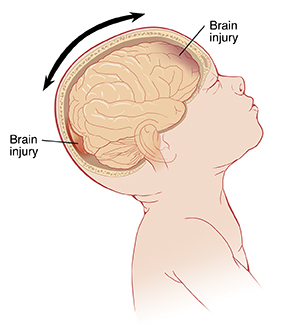Preventing Abusive Head Trauma
Shaking, hitting, throwing, or dropping a baby is very dangerous. It causes a serious problem called abusive head trauma (AHT). This includes shaken baby syndrome. AHT is a severe form of physical child abuse. This can lead to major brain damage and death. It can be frustrating when a baby won’t stop crying. The stress of caring for a baby puts a strain on the parents. It can be even more stressful if your baby has been sick. But no matter how fed up, tired, or upset you are, you should never shake, hit, throw, or drop your baby. AHT can be prevented.
Why it’s a problem
When a baby is shaken, hit, thrown, or dropped, the brain moves back and forth inside the skull. Even a little force could cause the brain to hit the inside of the skull. A baby's neck muscles can't support the stress of shaking. This can result in bleeding and swelling inside the skull. It can lead to permanent brain damage, learning disabilities, intellectual disability, blindness, deafness, seizures, paralysis, coma, or death. Babies who survive AHT will likely need lifelong medical care. Nearly all victims of AHT suffer serious, long-term health consequences.
 |
| If a baby is shaken, the brain can hit the inside of the skull. |
If you’re frustrated
If you feel yourself getting fed up, here’s how to cope:
-
Understand that a baby's crying is worse in the first few months of life, but it will get better as the child grows.
-
Put the baby down in a safe place, such as their crib, even if the baby is crying.
-
Take a deep breath. Walk away. Count to 10. Do whatever else you need to do to calm down.
-
Let others help you take care of the baby. Trade off with your partner, the baby’s grandparents, or other family members.
-
Make sure the baby is fed and dry. Feed the baby slowly. Burp the baby often. Sing or talk softly to your baby. Rock your baby gently or go for a walk. Hold your baby against your bare skin (skin-to-skin). Take your baby for a ride in a stroller or car.
-
Talk with your baby’s healthcare provider about what’s causing the crying. There could be a health problem or other issue that’s making the baby cry more than normal. The healthcare provider can also give you ideas for how to console your crying baby.
-
If your baby’s healthcare provider believes your baby is just fussy, know that this is not your fault. Your baby will grow out of this period of fussiness. It does not mean the baby does not love you, or that you are not doing a good job. Healthy babies can cry for 1 to 2 hours at a time.
-
If you’re feeling overwhelmed, talk with your baby’s healthcare provider about childcare choices, counseling, or other resources that can help.
-
Call the Childhelp National Child Abuse Hotline at 800-422-4453. The trained operator can help you deal with your frustration, so you don’t hurt your baby.
-
Never leave your baby alone with a person who is easily irritated, or has a temper or a history of violence.
These tips should be also shared with all of your child's caregivers because babysitters and partners of the parent often feel frustrated by crying that doesn't stop.